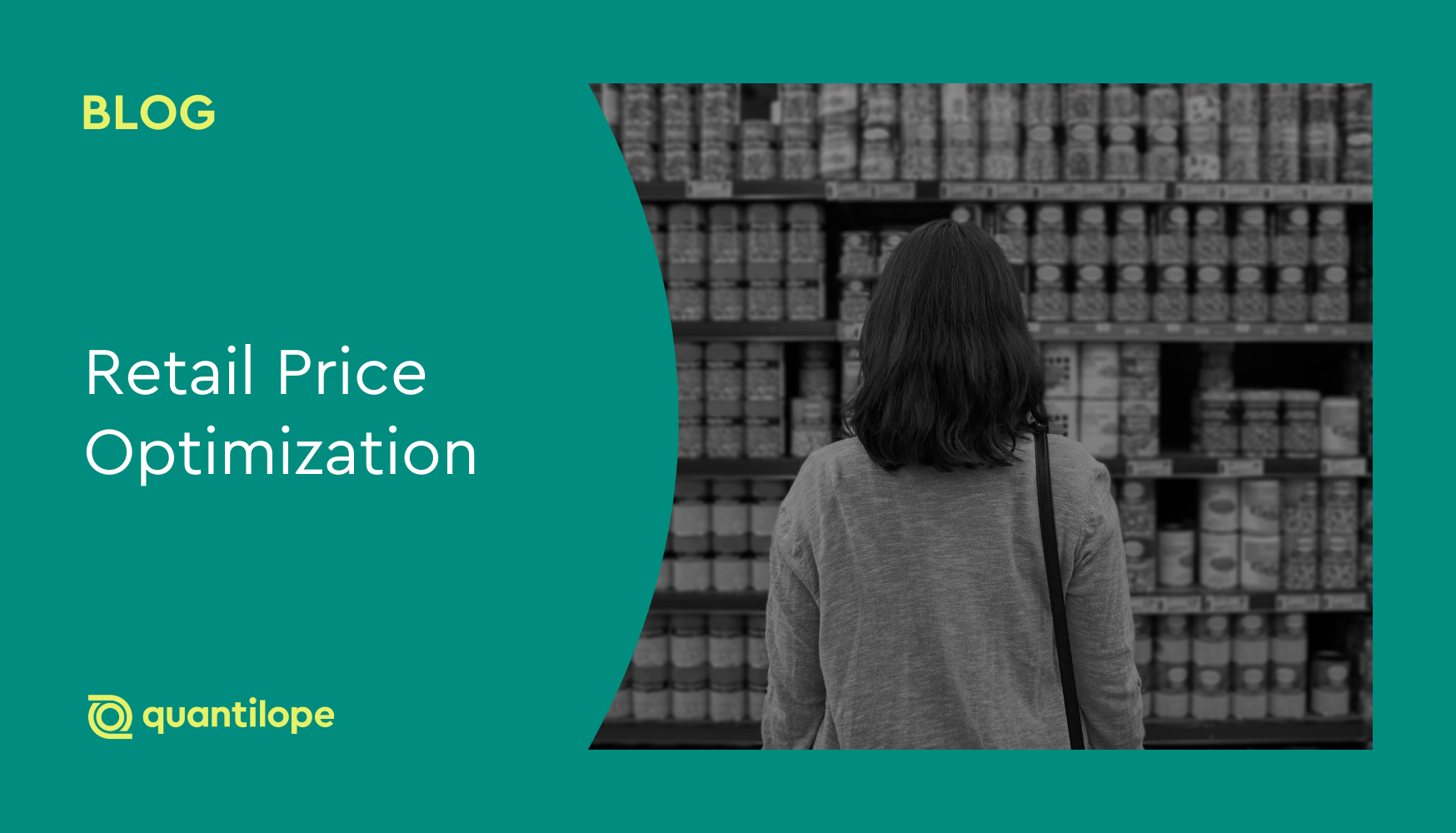In the ever-evolving retail landscape, where consumer preferences constantly shift, market trends fluctuate, and competition intensifies, one thing remains constant: pricing is (and always will be) a huge component of your success. Brands that prioritize retail price optimization research (leveraging data-driven insights to strategically set prices) will be the ones who drive more sales, stay ahead of their competition, and enjoy higher success.
Table of Contents:
- Understanding price optimization in retail
- The difficulties in determining an optimal retail price
- Automated pricing research methods for retail price optimization
- Benefits of using automated research platforms for retail price optimization
- Using quantilope as your automated price optimization solution
Understanding price optimization in retail
Price optimization for retail describes how brands use consumer market research to set the most effective price for their products/services to achieve specific business goals - typically ones related to hitting sales targets. You can’t simply set your price the lowest and hope for an influx of sales, or set your price the highest and hope your value shines through; it’s a delicate balance of finding an optimal price (or price range) that will attract customers while also ensuring healthy profit margins for your business.
There are several advanced methodologies that help brands understand an optimal price point for what they’re selling - such as Van Westendorp/Price Sensitivity Meter (PSM) and Choice-Based Conjoint. Later on, we’ll dive more into how these automated methodologies (among others) work for pricing research.
As a general understanding though, retail price optimization goes beyond your best guess at what an ideal price would be to confidently align your retail prices with market conditions and target customer expectations.
The difficulties in determining an optimal retail price
While quantilope’s automated platform makes it easy - determining an ideal retail price is far from simple.
When setting price points, brands need to consider a number of factors, including:
- Cost of goods: The cost of producing or procuring your products
- Economic conditions: Factors out of your control like inflation, recession, supply chain shortages, and consumer spending habits
- Market demand: How much customers are willing to pay for your products
- Competitor pricing: The prices your competitors are charging for similar products
- Brand image: The perceived value of your brand in the eyes of consumers
Attempting to manually analyze and consider all these constantly-fluctuating variables is frustrating, time-consuming, and highly prone to human error. Errors in any of the above calculations or estimates can lead to underpriced products that jeopardize profit margins or overpriced items that sit and gather dust on shelves.
To avoid this, retailers should leverage automated, advanced research methods that take these manual risks out of the equation.
Automated pricing research methods for retail price optimization
As mentioned above, manual calculations are not ideal for pricing research (or for most research for that matter!). By leveraging automated, advanced research methods, retailers can gain real-time, actionable insights into things like market dynamics, customer behavior and expectations, and competitor pricing - all of which guide retailers to make their own informed pricing decisions.
Below are a few automated pricing methods that retailers might leverage when trying to optimize their prices.
Price Sensitivity Meter (PSM)
Price Sensitivity Meter (aka, PSM - and also frequently referred to as Van Westendorp) is a quantitative research method that helps determine an optimal price point for a product. To leverage this for retail, retailers would survey their customers and/or target consumers about their willingness to pay for a particular product or service at different price levels. The PSM data then reveals specific price points and an overall price range where demand is highest and revenue potential is maximized (the optimal price point).
For more on PSM, check out quantilope's Price Sensitivity Meter method page.
Choice-Based Conjoint analysis (CBC)
Choice Based Conjoint (CBC) helps retailers understand how their consumers value different product attributes, including price.
Using a CBC methodology, a retailer would present respondents with various product configurations (changing the features in each configuration - such as different price points, sizes, brands, claims, etc.) and ask them to choose their overall preferred option; the results then show which attributes are most important, and which levels within those attributes (such as which brands or which packs specifically) are most preferred. Based on these insights, retailers can determine the relative importance of price compared to other features of their product/service to allocate their resources accordingly. They'll also learn which price point will help them to generate the most revenue in the end.
For more on this method, check out quantilope's blog on Choice-Based Conjoint for pricing research.
MaxDiff analysis (best-worst scaling)
MaxDiff (Maximum Difference Scaling, or, best-worst scaling) helps prioritize a long list of features or attributes - price included!
Retailers using this advanced methodology for price optimization research would ask respondents to choose the ‘best’ and ‘worst’ factors related to a product from a revolving set of options. For example, the first screen of a MaxDiff might show factors such as product price, product color, and product size. The next screen would then show a different combination of factors such as (again) product price, product scent, and product material. Through this series of choices, respondents reveal the relative importance they place on price compared to other product factors.
For more context on how this methodology differs from the above-mentioned CBC, check out quantilope's comparative blog post covering each method.
Benefits of using automated research platforms for retail price optimization
Knowing why it’s important to understand optimal retail pricing and how automated, advanced methodologies can help in doing so, below are a few benefits that retailers will enjoy when they opt for an automated research platform like quantilope:
Real-time responsiveness and agility:
With automated market research platforms, retailers can monitor real-time data for relevant market changes to react quickly on. Automated significance testing, algorithms, and machine learning work ‘behind the scenes’ to instantly point out when notable shifts occur in the data - such as when competitor prices fluctuate or market conditions shift significantly.
With this information, retailers can implement dynamic pricing (making price changes based on current market demands) to maximize their revenue potential.
Enhanced accuracy and efficiency:
Automated pricing research platforms lead to more accurate pricing decisions by virtually eliminating human error in data calculations and pricing analytics.
Instead of gathering and analyzing consumer data manually, automated platforms can instantly sift through vast amounts of data from various sources, including competitor prices, market trends, and customer behavior.
Deeper insights and granular analysis:
Advanced analytics and machine learning algorithms can identify subtle trends and correlations in pricing data that might be easily missed through manual analysis alone.
Dive into your automated platform data to analyze pricing insights by demographics, past purchase history, or other important criteria to understand how various customer segments will likely respond to price changes. This is especially useful in tracking projects where retailers can reference historical data for past pricing insights - such as consumers' reactions to past markdowns.
Competitive advantage:
Thanks to automated price optimization tools and platforms - researchers of any skillset can act on real-time market trends and leverage advanced method insights to stay one step ahead of the competition. By continuously monitoring market prices and adjusting their own accordingly, retailers can offer fair and competitive prices that resonate with customers, fostering trust and loyalty.
Real-time, automated access to insights is also particularly useful to capture seasonality-related pricing insights so retailers can react quickly and adjust their prices before an opportunity passes (or use it for next season’s forecasting!).
Using quantilope as your automated price optimization solution:
quantilope’s Consumer Intelligence Platform makes pricing decision-making faster, more advanced, and more efficient for retailers. With an instant lens into real-time customer behavior and the competitor landscape, retailers can optimize their pricing strategies for maximum profitability and sustainable growth.
Along with easily leveraging advanced pricing methods like PSM and CBC, quantilope users have the support of a trusted team of research consultants, and its AI co-pilot, quinn. quinn uses artificial intelligence to support researchers with advanced method survey inputs, chart headlines, and dashboard summaries - saving valuable time throughout the entire end-to-end research process. Even researchers who have never worked with pricing data analysis before can jump right into the platform knowing they have ongoing project support.
Whether it’s leveraging pricing research to set an initial price, find the best price for a particular group of consumers, grow market share, or simply make better decisions for your business, quantilope’s automated platform is your end-to-end resource.
To learn more about automated pricing research for retail pricing optimization, get in touch below!


